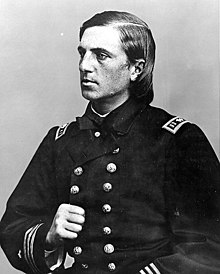William Barker Cushing
|
Commander William Barker Cushing |
|
|---|---|

Lieutenant William B. Cushing, USN
|
|
| Born |
4 November 1842 Delafield, Wisconsin |
| Died | 17 December 1874 (aged 32) Washington, D.C. |
| Buried at | United States Naval Academy Cemetery, Annapolis, Maryland |
| Allegiance | United States of America |
| Service/branch |
United States Navy Union Navy |
| Years of service | 1861–1874 |
| Rank |
|
| Commands held | |
| Battles/wars | American Civil War |
| Awards | Thanks of Congress |
| Relations |
brother Alonzo Cushing Brother Howard B. Cushing |
brother Alonzo Cushing
Commander William Barker Cushing (November 4, 1842 – December 17, 1874) was an officer in the United States Navy, best known for sinking the Confederate ironclad CSS Albemarle during a daring nighttime raid on October 27, 1864, a feat for which he received the Thanks of Congress.
Cushing was born in Delafield, Wisconsin, and was raised in Fredonia, New York. He was expelled from the United States Naval Academy, just before graduation, for pranks and poor scholarship. At the outbreak of the American Civil War, however, he pleaded his case to United States Secretary of the Navy Gideon Welles himself, was reinstated and went on to acquire a distinguished record, frequently volunteering for the most hazardous missions. "His heroism, good luck and coolness under fire were legendary."
Cushing saw action during the Battle of Hampton Roads and at Fort Fisher, among many others. He was promoted to lieutenant in 1862, and to commander in 1872. Two of his brothers died in uniform, one (Alonzo) in the Battle of Gettysburg for which he was awarded the Medal of Honor, and another (Howard) while fighting the Chiricahua Apaches in 1871. His oldest brother, Milton, served in the Navy as a paymaster.
It was Cushing's daring plan and its successful execution against the Confederacy's ironclad ram CSS Albemarle that defined his military career. The powerful ironclad dominated the Roanoke River and the approaches to Plymouth through the summer of 1864. By autumn, the U.S. government decided that the situation should be studied to determine if something could be done. The U.S. Navy considered various ways to destroy Albemarle, including two daring plans submitted by Lieutenant Cushing. They finally approved one of his plans and authorized him to locate two small steam launches that might be fitted with spar torpedoes. Cushing discovered two 30-foot (9.1 m) picket boats under construction in New York and acquired them for his mission. On each he mounted a 12-pound Dahlgren howitzer and a 14-foot (4.3 m) spar projecting into the water from its bow. One of the boats was lost at sea during the voyage from New York to Norfolk, Virginia, but the other arrived safely with its crew of seven officers and men at the mouth of the Roanoke. There, the steam launch's spar was fitted with a lanyard-detonated torpedo.
...
Wikipedia
